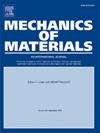Coupled effects of dispersions in interface sliding stress and fiber strength on tensile response of ceramic composites
IF 3.4
3区 材料科学
Q2 MATERIALS SCIENCE, MULTIDISCIPLINARY
引用次数: 0
Abstract
Micromechanics models for fiber-reinforced ceramic composites consider fiber strength as stochastic but assume other material properties are deterministic. However, experimental data show considerable variability in interface sliding stress within single composite specimens. This study advances the models by integrating sliding stress dispersions with stochastic fiber strength. We use analytical models and Monte Carlo simulations to investigate the combined effects of these dispersions in two scenarios: (i) a composite containing a single matrix crack bridged by fibers, where the matrix is rigid and cannot crack away from the main crack, and (ii) a composite with a single fragmenting fiber in a matrix that is heavily-cracked, unable to bear axial load but rigid in shear. Results show that dispersion effects in the first case lead to greater strength reductions than in the second. Dispersion effects are attributed to differences in characteristic fiber strengths, uniformity of fiber loading, and fractional lengths of slipped fibers. Analytical formulations describing the combined dispersion effects are also developed and evaluated. Finally, examination of the results reveals a deficiency in the single fiber composite model, highlighting a flaw due to the absence of kinematic constraints on fiber extension across matrix cracks.
界面滑动应力和纤维强度分散对陶瓷复合材料拉伸响应的耦合影响
纤维增强陶瓷复合材料的细观力学模型认为纤维强度是随机的,但假定材料的其他性能是确定的。然而,实验数据显示,单一复合材料试样的界面滑动应力具有相当大的变异性。该研究将滑动应力色散与随机纤维强度相结合,提出了模型。我们使用分析模型和蒙特卡罗模拟来研究这些分散在两种情况下的综合影响:(i)复合材料含有由纤维桥接的单一基体裂纹,其中基体是刚性的,不能从主裂纹中开裂;(ii)复合材料中含有单个断裂纤维,其严重开裂,无法承受轴向载荷,但在剪切时是刚性的。结果表明,第一种情况下的分散效应比第二种情况下的强度降低更大。色散效应是由于纤维特性强度、纤维负载均匀性和滑移纤维长度的差异造成的。还开发并评价了描述复合色散效应的解析公式。最后,对结果的检查揭示了单纤维复合材料模型的不足之处,突出了由于缺乏对纤维在基体裂纹上延伸的运动学约束而导致的缺陷。
本文章由计算机程序翻译,如有差异,请以英文原文为准。
求助全文
约1分钟内获得全文
求助全文
来源期刊

Mechanics of Materials
工程技术-材料科学:综合
CiteScore
7.60
自引率
5.10%
发文量
243
审稿时长
46 days
期刊介绍:
Mechanics of Materials is a forum for original scientific research on the flow, fracture, and general constitutive behavior of geophysical, geotechnical and technological materials, with balanced coverage of advanced technological and natural materials, with balanced coverage of theoretical, experimental, and field investigations. Of special concern are macroscopic predictions based on microscopic models, identification of microscopic structures from limited overall macroscopic data, experimental and field results that lead to fundamental understanding of the behavior of materials, and coordinated experimental and analytical investigations that culminate in theories with predictive quality.
 求助内容:
求助内容: 应助结果提醒方式:
应助结果提醒方式:


